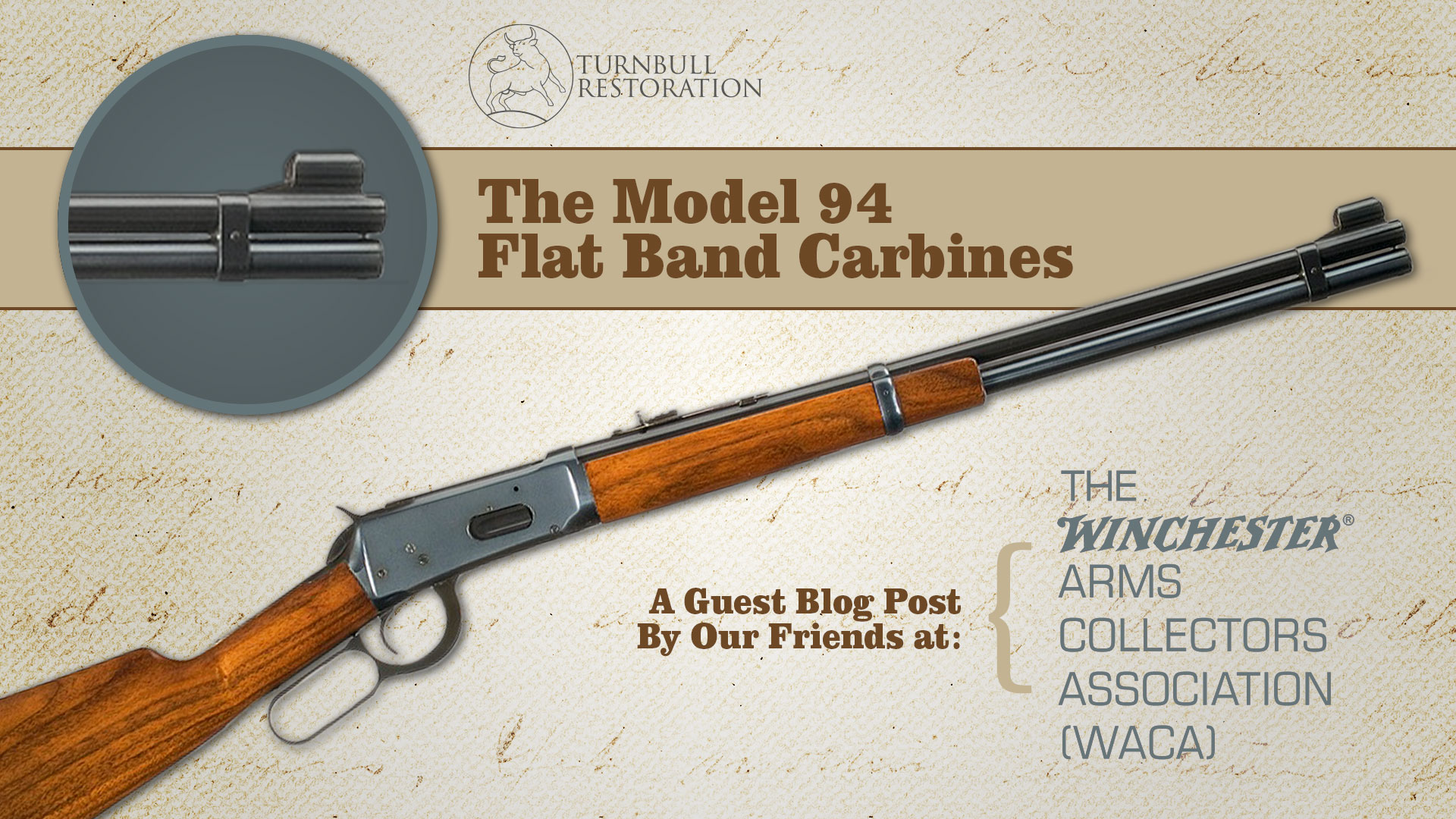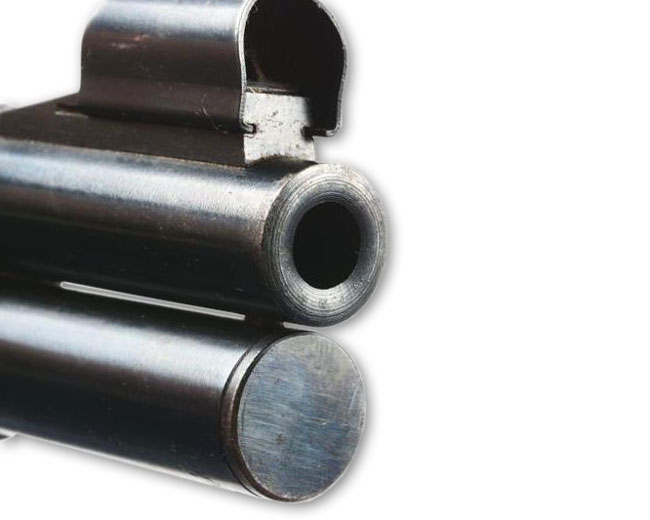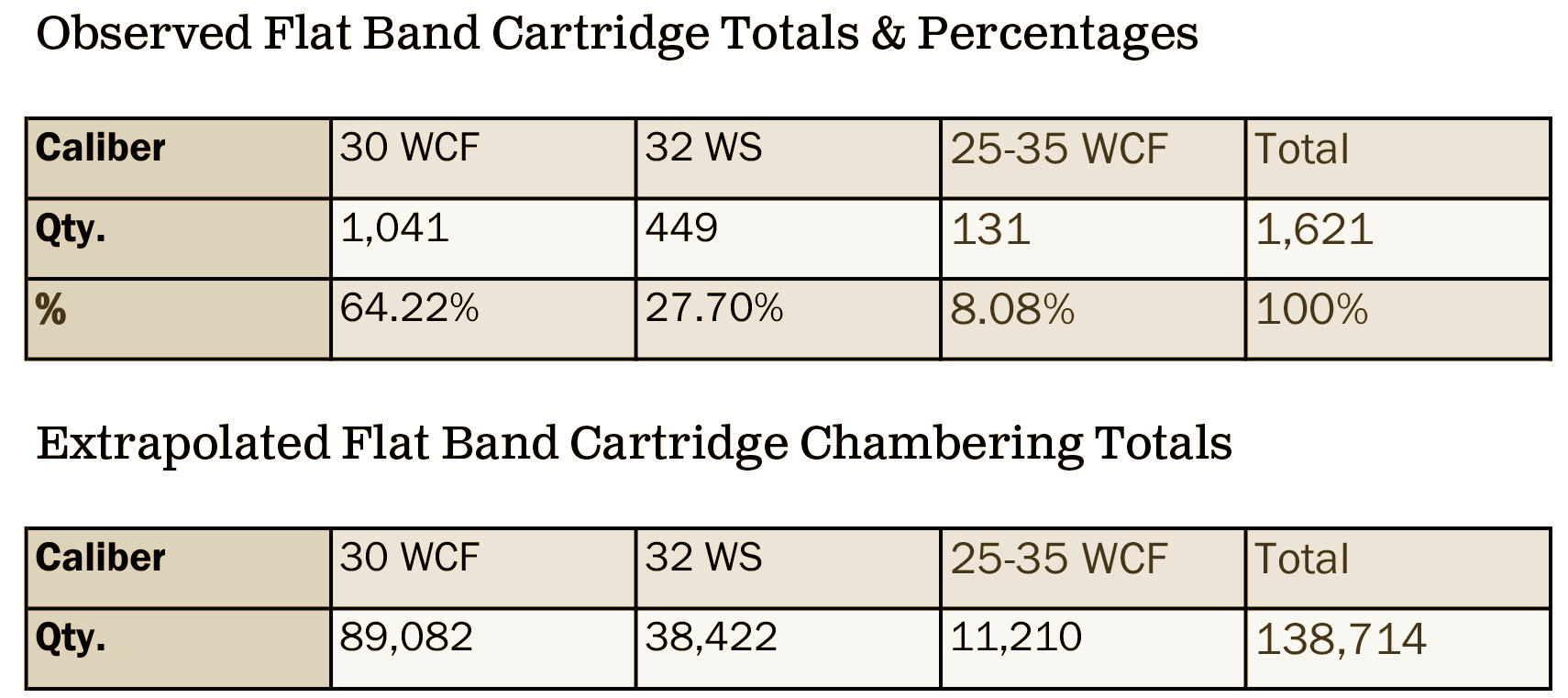We’re excited to publish the first in a series of guest blog posts graciously provided by our friends at the Winchester Arms Collectors Association (WACA).
WACA is a not-for-profit, tax-exempt corporation with a worldwide membership of over 3,000. The members are devoted to the preservation, understanding and collecting of Winchester firearms and related products as well as the role these products had in forging America’s heritage. As WACA members ourselves, we’re proud to play our part in this mission.
Our goal with this guest blog series is to share WACA members’ outstanding knowledge and passion for Winchester firearms. We will share articles aimed at informing Winchester owners and enhancing their collecting experience, along with personal stories and memories related to Winchester firearms that we hope will resonate with you as much as they do with us.
Without further ado, here’s our first WACA guest post. We encourage your thoughts in the comments section below.
The Model 94 Flat Band Carbines
by Bert Hartman #6571L
The Model 94 Carbine evolved frequently during its 123-year lifespan, and as a result of its continual evolution, many uniquely different variations were produced. One of the more noticeable variations manufactured was one that we collectors refer to as the “Flat Band” Carbine.
Setting the Record Straight on Winchester Model 94 Flat Band Carbine Production
It has often been written and discussed that the Flat Band Carbine came to be as the result of Winchester’s efforts to support WWII firearms production, and that they were manufactured in the years 1943–1948. However, and as you will soon discover in the presented facts to follow, the Flat Band Carbine variation was just another example of Winchester’s frequent attempts to reduce the production time and cost… after WWII had ended and sporting firearms production had been resumed.
When discussing the “Flat Band” Carbine, it is in direct reference to the front barrel band, which was formerly manufactured with a rounded milled contour, both examples shown below.
(Related: Winchester Model 1894 restoration examples)
Flat Band vs. Milled Band
Winchester Model 94 Flat Band Carbine Production Notes
Serial Numbers
Production of the Flat Band Carbine began approximately nine-months after Winchester had resumed production of the Model 94 following WWII. Based on the observed serial number range of the specimens surveyed thus far, the first Flat Band Carbines were manufactured in mid-July of the year 1946, beginning very near serial number 1373600 (there have been a very small number of specimens found with earlier serial numbers, but they were undoubtedly a case of Winchester using up older receivers).
Production of the Flat Band ended in mid-December of the year 1948 (approximately serial number 1547300), after nearly 139,000 of them had been manufactured, and again, a small number of parts clean-up specimens have been found as late as February 1949. Based on the detailed examination of several dozen Flat Band Carbines, thus far all of the verified barrel dates have been “46”, “47”, or “48.”
Calibers and Features
When the Flat Band Carbine production began in July of 1946, it was available in all three of the standard calibers; .25-35 WCF, .30 WCF, and .32 WS. The second model (type 2) receiver frame was standard, with a checkered (knurled) hammer, a slotted magazine tube cap, and a flat checkered steel butt plate. The upper tang was unmarked, and it was not drilled and tapped for a tang sight. Winchester had not yet begun drilling and tapping the left side of the receivers for mounting a peep sight as a standard feature, but that option could have been special ordered (for a Lyman No. 48 receiver sight).
Production Changes
During the 30-month production run of the Flat Band Carbine, several notable production changes took place:
- The old style checkered (knurled) hammer was replaced with a serrated hammer: s/n range 1411700–1412400 (February 1947). See images 1 and 2, below.
- The contour (shape) of the upper tang to receiver frame juncture was altered, resulting in what I refer to as the Type 3 receiver frame—serial range 1472000–1473800 (January 1948). Note that the transition point from the tang to the receiver is much sharper (nearly a 90-degree turn), whereas the Type 2 frame (seen in the pictures of the hammer types) has an approximate 45-degree turn at the transition to the receiver. See image 3, below.
- Though the change to the receiver frame may appear to be subtle to the casual eye, it did cause a corresponding change to the shape and inletting of the butt stock at the upper tang to receiver frame juncture. The butt stocks cannot be readily interchanged between a Type 2 and a Type 3 receiver frame.
- The slotted magazine tube end cap was replaced with a smooth non-slotted cap—serial range 1532000 (September/October 1948). See images 4 and 5, below.
Production Change Examples
Winchester 94 Flat Band Carbines: As Rare as One Might Think?
As a point of interest, from the very first Flat Band Carbine serial number recorded in the research survey to the last one recorded thus far, the span of serial numbers is 190,144. Inside of that span, I have surveyed a total of 2,222 serial numbers (1.17%), with 1,624 of them being Flat Bands (73.09%), 442 being Model 64 Rifles (19.8%), and the remainder being Model 94 Carbines with a milled front band (in both the early and the late serial number transition ranges). When all of the totals are extrapolated, it indicates that approximately 139,000 Flat Band Carbines were manufactured.
There are a fair number of collectors and dealers that are of the opinion that the Flat Band Carbine variation is rare (and worth a premium), but this author/collector does not share that opinion. In support of my statement, there were many Winchester lever action models (e.g. the Models 53, 55, 64, 65, and 71) where the production totals for each did not come close to 139,000, and they are not considered to be rare. See the chart below.
Participate in the Winchester Model 94 Flat Band Carbine Survey
As always, I look forward to hearing from all interested Model 94 collectors, and especially those who would like to contribute to the ongoing research survey. If you would like to participate in the survey, please contact me via e-mail or call (360) 881-0272 (evenings, Pacific Standard Time), or visit the WACA website forums by clicking here.
Reproduced with kind permission from the Winchester Arms Collectors Association (WACA). All images courtesy of WACA.
More About the Winchester Arms Collectors Association
This article was previously published in the Winter 2018 issue of The Winchester Collector. To greatly enhance your collecting experience, join the Winchester Arms Collectors Association (WACA). It’s only $50 per year, and you’ll receive our quarterly magazine with great articles on historic Winchesters and Henry rifles, along with many other member benefits such as 15 additional record searches for Cody Firearms Museum members. It’s easy to join online with a credit card by clicking here.

Related Content
Exploring the Classics: Winchester Model 1894
View additional guest posts by Winchester Arms Collectors Association
View additional guest posts by Bert Hartman, WACA Historian










I have one of the flat band 30 WCF model 94 carbines. Serial number 1509725 I believe it was probably made in 1947-48?
Hello Scott,
Your Model 94 Flat Band was manufactured in late June or early July of 1948. If you would like to confirm that exact date, contact Paulin Muerrle – https://paulinemuerrle.com/
Based on the date it was manufactured, it should have a serrated hammer, with a Type-3 receiver and a slotted magazine end cap. The barrel date will undoubtedly be “48”.
Serial 1546453 in 32 WS made in 1949? A late flat band?
informative article
I also have a flat band 30wcf model 94 carbine Sn 1416090. It was my great grandfather’s then my grandfather’s and he gave it to me a few a years back just before he passed. It was his original deer hunting rifle and now I use it as my close range deer rifle. I will have this for rest of my life until I get to pass it on to my grandkids.
Hello Brian,
Your Flat Band Carbine was manufactured in approximately March 1947. If you would like the exact date, contact Pauline Muerrle – https://paulinemuerrle.com/
Based on when it was manufactured, it should have a serrated hammer, Type-2 receiver, and slotted magazine end cap. The barrel date could be “46” or “47”.
I have 94 30 WCF flat band with a knurled hammer and slotted end cap
S/n starts at 137
I’m guessing it’s a 1946 ?
I have a 94 flat strap ser # 1205077
it has a knurled hammer
it has a slotted mag tube end
the barrel and top of receiver has a stamp PWL in a vertical brand like presentation that is encircled
it has a Redfield sight.
the previous owner told me it was built in 1944 ?
i have a winchester model 94-wcf with a flat band. it has a slotted magazine tube end cap. it has serrated hammer. serial # 1495225
i hope this helps. fill free to reply with any info about it you might have.
Hello Klay,
Your Flat Band Carbine was manufactured approximately in May 1948. An exact date can be obtained from Pauline Muerrle – https://paulinemuerrle.com/
It should have a Type-3 receiver, and a barrel date “48”.
I have a flat band in 30WCF with serial # 1414799, slotted mag tube ad serrated hammer.
I have a Winchester 94 with serial number 1402116, which I guess is from 1946. The weird thing is that the barrel is marked: -30-30- and not 30.wcf. Many believe the barrel has been changed, but the owner denies this. The owner bought the weapon in Greenland in 1949 and owned it since. The weapon was new when it was purchased. What do you think?
Hello Øystein,
Winchester did not change the caliber marking from the earlier “30 W.C.F.” to the later “30-30 WIN.” until the Spring of the year 1950. The serial number (1402116) on your Model 94 tells us that it was manufactured in December of 1946. If you check the barrel date stamped on the underside of the barrel, it will tell you what year it was manufactured. If no date stamp is found, that would indicate that the barrel was manufactured sometime after 1955.
Regards,
Bert Hartman
WACA Historian
My Uncle Walt purchased his flatband 94 ser. #1380716 for his wife “Blanche” when he was owner/operator of Staley Springs Lodge at Henry’s Lake Idaho.
I borrowed it and shot a beautiful 4×5 Mule Deer Buck back in 1982 at 16 yrs old.
Walt’s son gave it away shortly thereafter which broke my heart.
JD..Walt’s son came back through Idaho Falls in 2020 or so & was in poor health, I ended up visiting him everyday for 2-3 weeks whereas somewhere along the line, I had a dream about JD giving me the model 94.
The next day when I went to visit him, he told me that his old friend “the one he’d gave the rifle to back in 1982-3” had given the winchester back to him.
Unbelievably, JD gave me the rifle a day or two later…it was wonderful and made me so incredibly proud/happy to be able to hunt with my Aunt & Uncles 94-30WCF again that it still brings tears to my eyes retelling this story some 39-40 yrs after JD had originally given it away.
Yahoo!!!!!!!
Hey there, I have a Flat Band Winchester as well in 30WCF with the serial number 1381148. It was a great gift from the wife’s grandfather and completely unaltered.
Hello Josh,
Your Model 94 Flat-band is one of the early production specimens manufactured in late August of 1946.
My favorite gun has always been my grandpas model 94, it’s serial is # 1111440, my dad passed away and I ended up with it, now my son is in college and for fun they have been going out in the desert to shoot, he asked if he could shoot the cowboy gun, now the 4th generation is using the same gun, I love it
I have a Winchester 94 that has the flat band and has serial # 947092, which should date it to 1923. The rifle is a deluxe model and has cut checkering on the pistol grip and forearm. I believe I am the second owner. The original owner owned a camp in the Kildare area north of Tupper Lake, NY. I knew him from the time I was about 2-3 years old and he used to take be trout fishing at his camp in the wilderness at his “private” pond. The pond was loaded with Brookies. Every trip included tearing out beaver dams and shooting beavers. He told me he purchased it in the 1920’s and carried it daily to clear the beavers out that built dams flooding his camp. It is basically chrome in the area around the barrel/receiver and certainly my most prized rifle. He had a Marbles tang sight installed on it. I use it as my stalking/tracking rifle. I have taken a few deer with it, I’m sure he tool many, many more. I have other M94’s and have handle many more, but none are as smooth as this one.
Great comments and learning a lot from them. I just bought a 46 without the flat bands or band. Looking forward to see if it’s all original with stamped under barrel with year and checked trigger, proper site, etc, etc. Many thanks to all
Great info. I have a model 94 flat strap 1458861 my dad purchased new in the late 40’s or early 50’s. I killed my first deer with it in 1970 at age 13.
I encountered a fellow trying to sell a canvas bag full of abused and rotted firearms at my lgs. They were not interested, of course, but I spied a sad, rusted 94 with a frozen open action in the lot and acquired, rescued, and cleaned it up. It’s now a classic, if imperfect piece with a worn-grey-turning to brown patina receiver 1511595. 1948. Flat front barrel band. Serrated hammer. Diamond patterned steel butt plate, slotted magazine cap. (The bore was fine. A liberal soaking with Ballistol got the action working smoothly.)
I first read about the Winchester Model 94 Flat Band Carbines about 30 years ago. After reading about them, I decided that I had to have one. I always knew that I wanted a Pre-64 Model 94, but the Flat Band seemed very interesting to me, and as you said it was written that they were rarer and worth more money. I found a very one serial number 1501655 on one of the auction sites with a reasonable BIN price. I may be wrong, but I thought that another feature of the Flat Band Carbines was a longer wood forearm, which this rifle has. The wood is rather plain with no checkering which is how I believe all of them are made. My rifle is in .32WS. I am not exactly sure when it was manufactured, but would guess around June 1948.
I have a Flat Band 30 WCF serial number 1400023 . Love it very much so.
I passed on a flat band 32ws today for 1250. probably a 95 percent gun or a little better. did I do the right thing.?
I have a flat band 30 WCF with checkered stocks and recoil pad instead of metal butt plate Serial number 1405909
I have a Winchester 94 flat band in 32 special that appears to be in mint condition – likely un-fired. Would anyone be able to help me verify this? Thanks. Bluing is perfect and in my evaluation has not been polished.
I have a model 94 Flat band carbine. It was in bad shap when I purchased it. serial # 1484185
Lots of rust and pitting.
I have serial #1435734. Is a 98-99% gun. Great shooter.
I have a 32WS flatband serial no 1459444 is that 1946 or 47 ?
hello to all
I have a 32 special 1946 serial number 1367576 and I need to sell, some one know how much I can sell this rifle
thanks in advance.